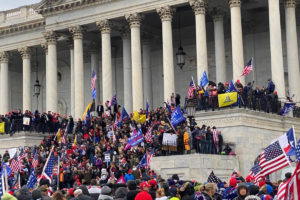Yesterday The American Spectator published the second installment in my series about the 2024 presidential election in Pennsylvania.
Much to my surprise it was featured by Real Clear Politics and has generated a fair amount of comment.
Here it is.
Report From Pennsylvania: Part Two
Republicans have made great strides in voter registration. But so have unaffiliated voters. In the end, what does it mean?
By George Parry

This is part two of George Parry’s assessment of the 2024 election in Pennsylvania. Find part one here.
According to the Pennsylvania Department of State’s presidential election data, in 2020 Joe Biden won Pennsylvania by 80,555 votes. When he did so, Pennsylvania Democrats had a 685,818 voter registration advantage over Republicans.
But today, thanks in significant part to an aggressive and prolonged statewide Republican voter registration campaign, the Democrat advantage has been reduced to 297,824.
Regarding this remarkable achievement, the Oct. 24 edition of the Philadelphia Inquirer offered the following:
“We’ve made up ground … since the last presidential election,” Trump senior adviser and Pennsylvania native Tim Murtaugh said. “Do you think that happened by magic? That’s the ground game. Registering voters is tangible proof of the strength. This hasn’t been cooked up in the last month. It takes a long time to make up a [300,000] voter registration advantage.”
With the close last week of registrations, the voter tally is 3,971,087 Democrat, 3,673,242 Republican, and 1,442,944 unaffiliated or other parties.
There are 67 counties in Pennsylvania, and Republicans have had net registration gains in 60 of them. Democrats have increased their registration advantage in only three counties. But, since 2020, there have been 1,139,176 new voter registrations, of which 431,820 are Democrats, 399,354 are Republicans, and 308,002 are unaffiliated. Put another way, though the Democrat new registrants led the Republicans by only 32,466, the unaffiliated new registrations are close behind both parties. This movement to the unaffiliated ranks is underway across America.
The point here is that, with 1.4 million unaffiliated registered Pennsylvania voters and a 2020 victory margin of 80,555 votes, the overall significance of the narrowing of the Democrat-Republican registration edge — though encouraging — becomes somewhat murky.
In any event, after four years of Bidenomics, the Democrats’ hold on Philadelphia has begun to erode. Consider the story bearing this headline from the Oct. 2 edition of the Philadelphia Inquirer:
In deep-blue Philly, working class voters are shifting toward Republicans. Democrats have lost the most ground in neighborhoods where poverty rates are the highest. It could hurt Kamala Harris in November.
(Author’s note: As a former contributor to the Inquirer, it is a credit to the paper’s hyper-woke editorial board that they ran this piece despite what must have been their overwhelming anguish at doing so.)
What follows is a well-sourced analysis of the profound changes in the Philadelphia electorate as the Democrats have become the party of the wealthy managerial class and the Republicans have become the party of the working class. It opens with the story of Gabriel Lopez, a 27-year-old home health aide, who “grew up in a family of Democrats in the Kensington neighborhood of deep-blue Philadelphia.”
Lopez voted for Hillary Clinton in 2016, but this year switched his registration to Republican and plans to vote for Trump. Here’s what he told the Inquirer:
“Democrats keep saying [Trump] is going to bring down the economy, but he was already president for four years, and taxes were lower. We’re tired of the same politics. We got a different kind of guy, and the people actually love him.”
Then there is this from Rafael Alvarez Febo, a Puerto Rican LGBTQ community leader who plans to vote for Kamala Harris:
“Many of us have people in our families who have gone to jail, or gone to schools that have failed us. We’re not trustful of the government. Then you have someone like Trump, who is a liar, and for some people it’s like, ‘you know something? He’s an honest representation of what we feel.’”
Then there is Charlie O’Connor, a Republican leader in Philadelphia’s 45th Ward, who advises that hundreds of former Democrats in his area have switched to Republican. Quoth O’Connor:
“The question you ask at the door — doesn’t matter, Black, white (sic) — is: Are you better off than you were four years ago? That’s the universal message. And people aren’t.”
And later in the article, O’Connor sums it up this way:
“When I first started in politics in 1978, the managerial class was Republican — no one votes the way their bosses vote. Now, most people in the managerial class vote Democratic and no one is voting the way their boss is. Most of the Democrats and the Democratic Party has (sic) become the party of the upper middle class.”
The article notes that, in 2020, Philadelphia accounted for 20 percent of Pennsylvania’s Democrat vote. But by 2022, that had dropped to 15 percent and is expected to go lower in 2024 as the working class — Black, White, and Latino — continues to “move right.”
All of this, of course, is good news for Trump. The challenge facing Philadelphia’s Democrat machine is how to convince working-class voters that the “reproductive rights” so valued by relatively well-off suburban women and “saving democracy” from Trump (who somehow forgot to destroy democracy during his previous term in office) are more important than eating, having a roof over your head, and paying the bills.
Or, as Alavarez Febo described Democrat efforts to turn out the Philadelphia vote, “They’re saying Kamala is going to save our democracy. That means very little for people who can’t keep the lights on.”
But in the end, what does all this mean when it comes to actual voting?
The Republican registration effort is premised on the belief that, as a general rule, people will vote consistent with their party affiliation. However, while the increased Republican registrations are welcome news, it is prudent to consider this note of caution from the Pew Research Center:
Partisan identification provides a broad portrait of voters’ affinities and loyalties. But while it is indicative of voters’ preferences, it does not perfectly predict how people intend to vote in elections, or whether they will vote.
Just so. In fact, party registration all too often lags behind voting behavior.
On the other hand, increased voter registrations do provide party leaders with longer lists of potential donors and more targets for voter turn out efforts.
Which brings us to the massive and — for Republicans — innovative efforts to “chase the vote” that are underway in Pennsylvania.
That will be the subject of my next installment. So stay tuned.
George Parry is a former federal and state prosecutor and retired trial lawyer. For many years he was a contributor to the Philadelphia Inquirerbefore it descended into woke madness. He blogs at knowledgeisgood.net.




1 Comment
Leave your reply.